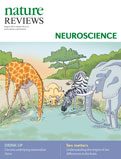|
Advertisement | |||||||||||||||||||||||||||||||||||||||||||||||
| |||||||||||||||||||||||||||||||||||||||||||||||
| TABLE OF CONTENTS | |||||||||||||||||||||||||||||||||||||||||||||||
| August 2017 Volume 18 Number 8 | |||||||||||||||||||||||||||||||||||||||||||||||
| In this issue
| ||||||||||||||||||||||||||||||||||||||||||||||
| |||||||||||||||||||||||||||||||||||||||||||||||
 | |||||||||||||||||||||||||||||||||||||||||||||||
| |||||||||||||||||||||||||||||||||||||||||||||||
| PROGRESS | Top | ||||||||||||||||||||||||||||||||||||||||||||||
| Neural circuits underlying thirst and fluid homeostasis Christopher A. Zimmerman, David E. Leib & Zachary A. Knight p459 | doi:10.1038/nrn.2017.71 Thirst is a homeostatic response to changes in fluid balance and is governed by a set of interconnected brain structures known as the lamina terminalis. In this Progress article, Knight and colleagues summarize recent updates to our understanding of the neural circuitry underlying thirst and drinking behaviour in mammals. Abstract | Full Text | PDF | |||||||||||||||||||||||||||||||||||||||||||||||
| Advertisement | |||||||||||||||||||||||||||||||||||||||||||||||
| |||||||||||||||||||||||||||||||||||||||||||||||
| REVIEWS | Top | ||||||||||||||||||||||||||||||||||||||||||||||
| Neuroimmunology and neuroepigenetics in the establishment of sex differences in the brain Margaret M. McCarthy, Bridget M. Nugent & Kathryn M. Lenz p471 | doi:10.1038/nrn.2017.61 Sex differences in behaviour and disease vulnerability are mirrored by the cellular and molecular sexual dimorphism of the brain. McCarthy and colleagues review findings that have highlighted the roles of inflammation and epigenetics in sex-specific brain differentiation and function. Abstract | Full Text | PDF | |||||||||||||||||||||||||||||||||||||||||||||||
| Taste buds: cells, signals and synapses Stephen D. Roper & Nirupa Chaudhari p485 | doi:10.1038/nrn.2017.68 Mammals detect the nutrient content, palatability and potential toxicity of food through taste buds that are present mainly in the tongue. In this Review, Roper and Chaudhari discuss the taste bud cells, receptors and transmitters that are involved in taste detection, how these cells communicate with sensory afferent fibres, and peripheral taste coding. Abstract | Full Text | PDF | |||||||||||||||||||||||||||||||||||||||||||||||
| Mammalian empathy: behavioural manifestations and neural basis Frans B. M. de Waal & Stephanie D. Preston p498 | doi:10.1038/nrn.2017.72 Empathy is a characteristic of all mammals that ranges from being sensitive to another's emotions to adopting their perspective. In this Review, de Waal and Preston discuss current hypotheses concerning how the emotional states of others are understood in a variety of species. Abstract | Full Text | PDF | |||||||||||||||||||||||||||||||||||||||||||||||
| Erratum: Non-motor features of Parkinson disease Anthony H. V. Schapira, K. Ray Chaudhuri & Peter Jenner p509 | doi:10.1038/nrn.2017.91 Full Text | PDF | |||||||||||||||||||||||||||||||||||||||||||||||
| |||||||||||||||||||||||||||||||||||||||||||||||
You have been sent this Table of Contents Alert because you have opted in to receive it. You can change or discontinue your e-mail alerts at any time, by modifying your preferences on your nature.com account at: www.nature.com/myaccount For further technical assistance, please contact our registration department For print subscription enquiries, please contact our subscription department For other enquiries, please contact our feedback department Springer Nature | One New York Plaza, Suite 4500 | New York | NY 10004-1562 | USA Springer Nature's worldwide offices: Macmillan Publishers Limited is a company incorporated in England and Wales under company number 785998 and whose registered office is located at The Campus, 4 Crinan Street, London, N1 9XW. © 2017 Macmillan Publishers Limited, part of Springer Nature. All Rights Reserved. |
 |









No comments:
Post a Comment